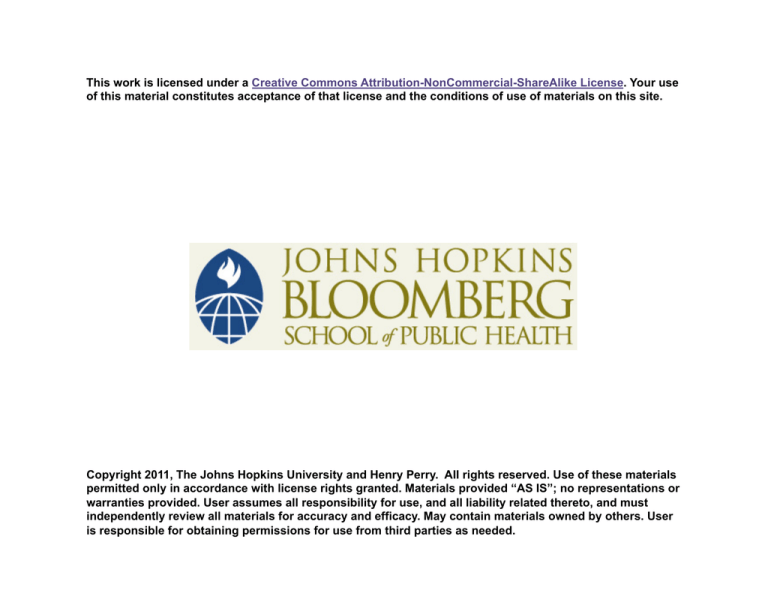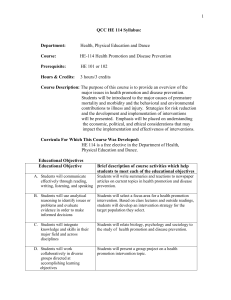
This work is licensed under a Creative Commons Attribution-NonCommercial-ShareAlike License. Your use
of this material constitutes acceptance of that license and the conditions of use of materials on this site.
Copyright 2011, The Johns Hopkins University and Henry Perry. All rights reserved. Use of these materials
permitted only in accordance with license rights granted. Materials provided “AS IS”; no representations or
warranties provided. User assumes all responsibility for use, and all liability related thereto, and must
independently review all materials for accuracy and efficacy. May contain materials owned by others. User
is responsible for obtaining permissions for use from third parties as needed.
Section C
Cross-Cutting Themes
Issues of Scaling Up
3
Lessons Learned: BRAC National ORT Promotion
Pilot everything
Training should be based on active learning
Use objective criteria to monitor program
- Checks of quality should exist at each level
Performance should influence pay
Evaluate frequently
- Modify program on the basis of evaluation results
Build teamwork; reach out to men and opinion leaders as well as to
mothers
4
Lessons Learned: BRAC National ORT Promotion
Going to scale does not necessarily result in a loss of quality
because management systems can be devised to assure quality at
any scale
Lay workers are effective conveyers of health information to change
behaviors
Source: Zaman and Karim. (2005). Learning to Reach Health for All.
5
Lessons Learned: BRAC National ORT Promotion
Collaboration between NGOs and government enhance program
effectiveness
Through developing greater levels of trust at the community level,
citizens can actively become involved in improving health practices
Source: Zaman and Karim. (2005). Learning to Reach Health for All.
6
Achieving Child Survival Goals
Source: (2007.) Lancet.
7
Issues Related to CHWs
With proper selection, training, and supervision, CHWs (volunteer
and paid) can be effective agents in reducing child mortality
Who is going to train and supervise them?
Who is going to make sure:
- They are not overloaded with too many tasks?
- They are addressing the priority conditions responsible for
preventable mortality in their communities?
8
Issues Related to CHWs
Who are they responsible to?
What incentives/salary are appropriate given the context?
How can CHW programs be scaled up and sustained?
9
Shasthya Shebikas
Shasthya Shebikas are CHWs trained and supervised by BRAC in
Bangladesh
68,000: helping to provide essential health care to 31 million people
- And TB services to 83 million
Each responsible for 100–150 households
Chosen by and responsible to the community
Unsalaried but receive minimal remuneration from sale of essential
health commodities
- For example, latrine slabs, sanitary napkins, soap
10
Activities of Shasthya Shebikas
Routine visitation of all homes with basic health education
- Including nutrition education
Childhood pneumonia detection and case management
- With supervision
Promotion of diarrheal disease prevention and treatment
Promotion of immunizations, family planning, antenatal/postnatal
care
Detection of symptomatic cases of possible TB, collection of sputum
specimens, provision of directly observed treatment (with
supervision)
11
Female Community Health Workers in Nepal
36,000 recruited in 1993
- But program was stopped after one year because government
couldn’t pay the stipend of $2 per month
National vitamin A program reactivated this resource by providing
training and local incentives (given preference in obtaining
government services—otherwise volunteer)
Critical for expanding vitamin A coverage and now are expanding to:
- Deworming
- Providing case management of childhood pneumonia
- Distributing iron tablets to pregnant women
12
Review of CHP and the Management of Sick Children
Even though there is strong evidence that community-based
treatment of pneumonia lowers under-five mortality, it is rarely
implemented, especially in Africa
In places where both malaria and pneumonia are major causes of
childhood morbidity and mortality, they should be managed
together by CHWs in the community
There is little follow-up information available about the CHW
programs of the 1980s
New and emerging strategies for CHWs need rigorous evaluation and
gradual scaling-up
Source: Winch et al. (2005). Health Policy and Planning.
13
Major Findings and Recommendations
From our own review
14
Factors Impacting CBPHC Child Survival Interventions
Emphasize “proven” CBPHC
interventions, allow for
innovation and flexibility
Strong professional/technical
leadership
Strong outreach
Strong supervision
Strong monitoring and
evaluation (M & E)
Partnership of respect and
trust between health system
and community
Functioning referral/counterreferral system
Long-term financial support
15
Importance of Reaching those Most in Need
“Unless services reach those most in need,
even the best conceived primary health care
and nutrition programs can obviously have
little impact on mortality.”
—Gwatkin, Wray, and Wilcox—1980
16
General Findings
Most evidence based on short-term efficacy studies of single
interventions
17
Frequency of Reports of Intervention Effectiveness
Intervention
Percent
Micronutrients
34.2
Promotion of good nutrition
33.0
Immunizations/immunization promotion (reports on measles, tetanus immunization)
32.8
Diarrhea prevention
31.0
Primary health care
28.2
Breastfeeding promotion
28.2
Diarrhea treatment
27.0
Neonatal/perinatal health care
25.6
Malaria prevention
22.4
Complementary feeding
21.8
Treatment of childhood illness/integrated management of childhood illness (IMCI)
18.4
Malaria treatment
17.5
Pneumonia treatment
17.2
Pneumonia prevention
14.7
HIV prevention (in children)
7.5
Neonatal tetanus treatment
3.7
Measles treatment
3.7
Congenital syphilis prevention
2.6
HIV/AIDS treatment (in children and adults)
1.4
Congenital syphilis treatment
1.1
18
Length of Studies Included in the Review
Duration of study
Frequency
Percent
Less than 1.0 years
69
19.9
1.0–4.9 years
194
56.1
5.0–9.9 years
56
16.2
10.0+
17
4.9
Not applicable
10
2.9
Total
346
100
19
Criteria
What criteria would you set to define whether a study is an efficacy
or an effectiveness study?
20
General Findings
We need more studies of the effectiveness (including mortality
impact) of integrated community-based programs in routine settings
at scale
We need more studies of the influence of community partnerships
and community empowerment in improving outcomes
- Those which do exist are compelling and should lead to further
experience and further evidence
21
General Findings
Relative lack of evidence about effectiveness of community-based
programs from Africa, compared to South Asia, except for malaria
interventions
Need more effectiveness studies at scale of community-based
programs integrating reproductive and child health
We need new methods to assess the effectiveness of large-scale
complex public health interventions
22
Conclusions
More emphasis on CBPHC is needed to accelerate progress in
reaching MDG4, especially in high-mortality settings, where health
systems are weak
More efforts are needed to involve the community as a partner in
order to help programs reach their full potential
Ongoing rigorous monitoring and evaluation of impact on under-five
mortality (and high-quality independent assessments published in
peer-reviewed journals) will be critical for long-term effectiveness
at scale
23
Community as a Resource
We need to learn how to better tap into the community as a
resource, not consider it just as a “target”
“We are convinced that if the development
agenda had recognized the existing strengths
in the African people and had built on them,
we would have gotten much further than with
the approach of treating African people as if
all they have is ignorance to be gotten rid of
and presenting them with solutions with no
bridges to their reality.”
—Miriam Were
2005 Gates Award Acceptance Speech
on behalf of AMREF
24
Community as a Resource
“We have the bullets but not the guns” for
waging war on child mortality and initiating a
second child survival revolution
—Cesar Victora
Global Forum for Health Research
Mexico City, 2004
It’s time to build an effective framework for delivering the
interventions collectively at scale for the long-term in partnership
with communities!
25
Conceptual Framework
A Conceptual Framework for Planning, Implementing,
and Evaluating the Effectiveness of Proven Technical
Interventions in Routine Field Situations at Scale
26
Alma-Ata: Rebirth and Revision 5
Increasing Empowerment
Information
Sharing
Source: (2008.) Lancet.
Consultation
Collaboration
Full
Responsibility
27
Delivering CBPHC Interventions for Children: Strategies
Home visitation
Participatory group meetings with women of reproductive age
Community-based treatment/referral of acute life-threatening
illness
Provision of services by a mobile team at outreach points accessible
to the population
Social marketing/commercialization of commodities
28
Delivering CBPHC Interventions for Children: Strategies
The delivery strategies and findings ways to optimize the
contributions of the communities are as important as the technical
content of the interventions themselves
Since the evidence is rapidly accumulating concerning the efficacy
of a growing number of CBPHC interventions for improving child
health, we need to start giving attention to the delivery strategies
and optimizing community engagement
29
Countdown to 2015 Report, 2008
30







